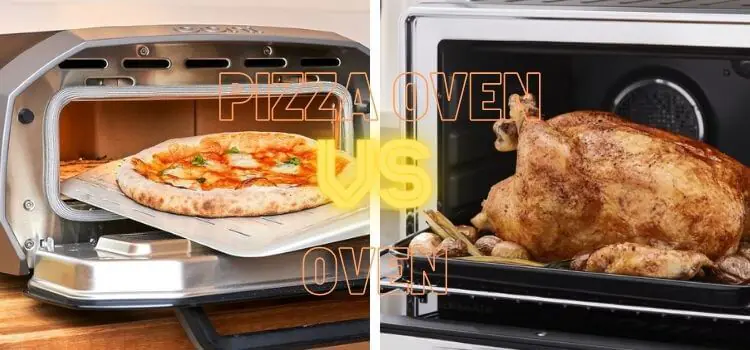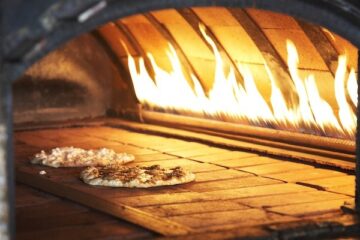Pizza ovens are specially designed to get the crust extra crispy without burning the top, making the texture of the pizza far superior to that cooked in a regular oven. The intense heat and stone deck of a pizza oven generate more heat and hold it well, causing a rapid oven spring and resulting in a crisp crust with a moist interior.
Regular ovens, on the other hand, tend to dry out the crust due to longer cooking times. Pizza ovens rely on circulating heat rather than an open flame to cook the food, and they are highly versatile, allowing you to cook a variety of dishes with the right tools and temperature control.
1. Pizza Oven Vs Oven: What’s The Difference?
When it comes to baking pizzas, you might be wondering: what’s the difference between a pizza oven and a regular oven? In this article, we will explore the unique features of each and discuss why a pizza oven is specifically designed for baking delicious pizzas.
Understanding The Unique Features Of A Pizza Oven And A Regular Oven
A pizza oven and a regular oven have distinct features that set them apart. A regular oven, often found in kitchens, is a versatile appliance used for cooking various types of food. It typically operates using electric or gas heat sources and offers different cooking modes such as bake, broil, and roast.
On the other hand, a pizza oven is specifically designed for baking pizzas. It is known for its ability to reach high temperatures quickly, allowing for fast and efficient cooking. Pizza ovens are often made of materials like ceramic or brick, which helps retain heat and distribute it evenly for perfectly cooked pizzas.
How A Pizza Oven Is Specifically Designed For Baking Pizzas
Pizza ovens are built with pizza enthusiasts in mind. They feature a specific design and construction that optimizes the baking process. The most notable feature of a pizza oven is its ability to reach high temperatures, typically exceeding 700°F (370°C). The intense heat and even distribution ensure that the pizza crust cooks quickly and becomes crispy while the toppings cook to perfection.
The design of a pizza oven also includes a dome-shaped chamber and a stone or brick cooking surface. This combination creates a radiant heat source that mimics the traditional wood-fired ovens used in pizzerias. The result? Authentic, restaurant-quality pizzas in the comfort of your home.
Exploring The Functionalities And Limitations Of A Regular Oven
While a regular oven is versatile and can be used for baking all sorts of dishes, it may deliver different results than a dedicated pizza oven. Regular ovens may take longer to preheat and may not reach the same high temperatures as pizza ovens. This can affect the overall texture and taste of your pizzas.
However, regular ovens have their own set of advantages. They offer a wider range of cooking modes and temperature settings, allowing you to experiment with different recipes. Regular ovens also have larger cooking capacities, making them ideal for cooking multiple dishes at once.
It’s important to note that while a regular oven can still produce delicious pizzas, it may achieve a different level of authenticity and perfection than a pizza oven.
When it comes to baking pizzas, a dedicated pizza oven offers unique features and advantages that set it apart from a regular oven. Its ability to reach high temperatures quickly and evenly distribute heat ensures perfectly cooked pizzas with crispy crusts and flavorful toppings. While a regular oven can still produce delicious pizzas, it may deliver a different level of authenticity. So, if you’re a pizza enthusiast looking for that true pizzeria experience, investing in a pizza oven can be a worthwhile choice.
2. The Crust Factor: Achieving The Perfect Crispy Crust
When it comes to pizza, the crust plays a crucial role in determining the overall taste and texture of the pie. Whether you prefer a thin and crispy crust or a more doughy and chewy one, the type of oven you use can greatly impact the final result. In this section, we will analyze the impact of oven type on crust texture, exploring how a pizza oven enables faster and more even heat distribution for a crispy crust. We will also delve into techniques you can employ to achieve a crispy crust in a regular oven.
Analyzing The Impact Of Oven Type On Crust Texture
When it comes to achieving the perfect crust, the type of oven you use can make all the difference. Pizza ovens, which are specifically designed for baking pizzas, offer several advantages over regular ovens. One of the key factors is heat distribution. In a pizza oven, the heat is distributed more evenly and at a higher temperature, resulting in a quicker cooking time and a crispier crust.
A regular oven, on the other hand, may offer a different level of heat distribution. The heat in a regular oven often comes from a bottom heating element, which can result in uneven cooking and a less crispy crust. Additionally, regular ovens may take longer to preheat, which can affect the overall texture of the crust.
How A Pizza Oven Enables Faster And More Even Heat Distribution For A Crispy Crust
A pizza oven is designed to achieve the perfect balance of heat distribution, ensuring a crispy crust every time. These ovens typically feature a stone or brick cooking surface, which helps absorb and radiate heat more efficiently. The high temperatures reached in a pizza oven, often exceeding 800°F (427°C), create an ideal cooking environment for the dough, allowing it to cook quickly and develop that sought-after crispy texture.
In addition to the stone or brick surface, pizza ovens also often feature a top heating element, which helps to brown the toppings while the crust crisps up evenly. This combination of heat from both the top and bottom ensures a perfectly cooked pizza with a crispy crust and well-cooked toppings.
Exploring Techniques To Achieve A Crispy Crust In A Regular Oven
If you don’t have a pizza oven at home, fear not! It is still possible to achieve a crispy crust using a regular oven with a few simple techniques. One popular method is to use a pizza stone or baking steel. Preheating the stone or steel in the oven before placing the pizza on top helps to absorb and radiate heat, resulting in a crispier crust.
Another technique is to increase the oven temperature to its highest setting and preheat the oven for an extended period. This allows the oven to reach a higher temperature, mimicking the heat of a pizza oven and enhancing the crust’s crispiness.
It is also important to ensure that your dough is rolled out thinly, as the thicker dough may cook less evenly and result in a less crispy crust. Additionally, using a lower moisture sauce and avoiding an excessive amount of toppings can help prevent the crust from becoming soggy.
3. Retained Moisture: Avoiding Dried Out Pizzas
Retained Moisture: Avoiding Dried Out Pizzas. When it comes to pizza ovens vs regular ovens, the main difference lies in the retention of moisture. Pizza ovens, with their high, circulating heat, bake crust to crispy perfection while keeping toppings from burning, resulting in a moist and flavorful pizza.
Understanding How Oven Type Affects Moisture Retention In Pizzas
When it comes to making the perfect pizza, moisture retention is key to ensuring each bite is bursting with flavour. The type of oven you use plays a crucial role in determining how well your pizza retains moisture. Let’s explore how pizza ovens differ from regular ovens in terms of moisture retention and how you can prevent dryness when using a regular oven.
The Role Of A Pizza Oven In Keeping The Pizza Moist And Flavorful
Traditional pizza ovens, whether wood-fired or gas-powered, are designed to create a hot and humid cooking environment. This high heat combined with the porous pizza stone or deck helps to absorb and distribute heat evenly, locking in the moisture and creating a crispy yet chewy crust. The intense heat of a pizza oven also ensures that the toppings cook quickly, preventing them from becoming dry and overdone.
In contrast, regular ovens, though versatile for various cooking purposes, don’t achieve the same level of moisture retention as pizza ovens. Regular ovens often lack the high temperatures and even heat distribution required to replicate the results of a pizza oven. As a result, pizzas made in regular ovens have a higher risk of drying out, leaving you with a less enjoyable eating experience.
Tips For Preventing Dryness When Using A Regular Oven
While a regular oven may not offer the same moisture retention as a pizza oven, there are still steps you can take to prevent your pizzas from drying out:
1. Preheat the oven: Make sure to preheat your regular oven to the highest temperature possible. This helps the oven reach its maximum heat, aiding in the creation of a burst of steam when you initially place the pizza inside. The steam helps to keep the crust moist and prevents dryness.
2. Use a pizza stone or baking steel: Investing in a pizza stone or baking steel can help replicate the effects of a pizza oven in a regular oven. These tools act as heat conductors, absorbing and radiating heat evenly, which can help prevent moisture loss and create a crispy crust.
3. Avoid overcooking: Keeping a close eye on your pizza while it’s in the oven can help prevent dryness. Monitor the cooking time and remove the pizza once the crust turns golden brown and the cheese melts. Overcooking can lead to moisture evaporation and a lacklustre pizza.
4. Optimize toppings and sauces: Choosing toppings and sauces that have higher moisture content can help prevent dryness. Rich tomato sauce, fresh mozzarella, and vegetables like mushrooms or bell peppers can add moisture and juiciness to your pizza.
By implementing these tips, you can improve the moisture retention in your pizzas when using a regular oven. While it may not match the results of a speciality pizza oven, you can still enjoy delicious, flavorful pizzas in the comfort of your own home.
4. Taste Test: Comparing Pizza Flavor And Quality
When it comes to pizza, the flavour and quality of the final product can make or break the dining experience. While both a pizza oven and a regular oven can bake pizzas to perfection, there are subtle differences that can significantly impact the taste. In this section, we will assess the influence of oven type on the overall taste and flavour profile of a pizza, explore the unique smoky flavours achieved with a pizza oven, and evaluate the taste and quality of pizzas baked in a regular oven.
Assessing The Influence Of Oven Type On Overall Taste And Flavor Profile
The type of oven used to bake a pizza can have a significant influence on its overall taste and flavour profile. While a regular oven can produce delicious pizzas, a pizza oven takes it to a whole new level. The intense heat generated by a pizza oven ensures the crust gets crispy on the outside while remaining soft and chewy on the inside. This high heat also results in faster baking times, allowing the dough to cook evenly and preventing sogginess. The result: a perfectly cooked pizza with a mouth-watering flavor and a tantalizing aroma.
Exploring The Unique Smoky Flavors Achieved With A Pizza Oven
One of the unique features of a pizza oven is the smoky flavours it imparts to the pizza. Pizza ovens, especially wood-fired ones, use real wood as fuel, which adds a distinct, smoky taste to the crust and toppings. As the wood burns, it releases aromatic compounds that infuse the pizza with a delightful smokiness. This adds layers of complexity to the flavour profile, making each bite a flavorful experience. Many people describe the smoky flavors as earthy, rich, and reminiscent of traditional Neapolitan-style pizzas.
Evaluating The Taste And Quality Of Pizzas Baked In A Regular Oven
While a pizza oven offers unique benefits, pizzas baked in a regular oven can still be delicious and satisfying. Regular ovens provide consistent and controlled heat, ensuring even cooking throughout the pizza. The taste and quality of the pizza will depend on the quality of ingredients, dough preparation, and baking techniques. With the right recipe and attention to detail, a regular oven can produce mouth-watering pizzas with a range of flavours and textures. While it may not have the same smoky notes as a pizza oven, a well-executed pizza from a regular oven can still delight the taste buds.
5. The Verdict: Which Oven Reigns Supreme?
Before we declare the supreme oven in the ultimate showdown between pizza ovens and regular ovens, let’s take a closer look at the pros and cons of each option. Understanding the differences will help you make an informed decision based on your specific needs and preferences.
Cost:
| Pizza Oven | Regular Oven | |
|---|---|---|
| Pros | – Affordable options available | – Usually included in kitchen appliances |
| Cons | – Some models can be expensive | – Initial cost is already included in kitchen setup |
Convenience:
| Pizza Oven | Regular Oven | |
|---|---|---|
| Pros | – Compact and portable options available | – Convenient for everyday cooking tasks |
| Cons | – Not suitable for large quantities of food | – Limited to the size of the oven |
Versatility:
| Pizza Oven | Regular Oven | |
|---|---|---|
| Pros | – Can be used for other types of cooking | – Wide range of cooking options available |
| Cons | – Primarily designed for pizza making | – Some specialized features may be lacking |
Considering these factors, it’s important to note that both pizza ovens and regular ovens have their advantages and limitations based on your specific requirements. However, if you are a pizza enthusiast and prioritize the authentic taste and crispy texture of the crust, a dedicated pizza oven might be the ideal choice for you. On the other hand, if you require a versatile cooking appliance for various dishes and convenience in everyday cooking tasks, a regular oven would be a more practical option. Ultimately, the decision lies in your personal preferences and needs.

Frequently Asked Questions On Pizza Oven Vs Oven
What Is The Difference Between A Regular Oven And A Pizza Oven?
A pizza oven is better for cooking pizzas because it generates more heat and has a stone deck that holds heat well. This creates a crisp crust with a moist interior, unlike regular ovens that can dry out the crust.
Pizza ovens rely on circulating heat, not open flames, to cook food.
Why Are Pizza Ovens Better Than Regular Ovens?
Pizza ovens are better than regular ovens because they generate more heat and have a stone deck for optimal cooking. The intense heat and circulating heat in pizza ovens result in a crispy crust and perfectly cooked toppings. Regular ovens can dry out the crust and do not provide the same level of heat for ideal pizza cooking.
Can You Use A Pizza Oven As A Normal Oven?
Yes, you can use a pizza oven as a normal oven. It is versatile and can cook various dishes at the right temperature with the appropriate tools. Pizza ovens create a crisp crust without burning the toppings, making them great for baking.
Why Is A Pizza Oven Better?
A pizza oven is better than a regular oven because it uses high, retained heat to bake the crust to perfection while cooking the toppings without burning them. The circulating heat in a pizza oven creates the ideal cooking environment.
Conclusion
Pizza ovens offer a unique cooking experience, bringing out a superior texture and flavour in pizzas. With high, retained heat and a stone deck, pizza ovens cook pizzas to crispy perfection while maintaining a moist interior. Unlike regular ovens, pizza ovens heat up to nearly twice as hot, ensuring a perfectly crispy crust without burning the toppings.
Whether you’re a pizza enthusiast or simply looking for a delicious, authentic cooking experience, a pizza oven is a worthwhile investment. Get ready to elevate your pizza game to the next level.

As the author of the “Ultimate Pizza Guide: Recipes, Tips & Secrets Revealed,” I’m dedicated to sharing my love for pizza and empowering others to create delicious homemade pizzas with ease. Join me on a journey to uncover the secrets to perfecting your pizza game!


